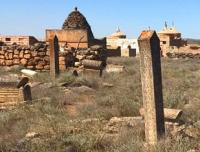You are here
Beysenbay necropolis.

Tours & Activities in sights of Mangyshlak.
“Only he deserves a monument who does not need it”
William Hazlitt (Hazlitt).
Monuments of history and culture of Kazakhstan.
Beysenbay necropolis is located at an altitude of 179 meters above sea level, located 25.8 kilometers east of the town of Fort Shevchenko, 8.9 kilometers south and slightly west of the Tamshaly tract, 5.8 kilometers north and slightly west of Hanga Baba necropolis, on the Tupkargan peninsula, in the Tupkaragan district in the western part of the Mangistau region.
The Beisenbay necropolis dates back to the XVIIth - XXth centuries, covers an area of 0.8 hectares. The necropolis is located on a slight hill 3.2-4 kilometers north and slightly west of the Sagyndyk necropolis. The Beysenbay necropolis consists of two mausoleums and several saganatams, built from sawn slabs of limestone-sandstone.
Clay mortar was used in the masonry; foundations were not installed. The main facades stood out in the form of portals, with raised walls at the corners. The domes of the mausoleums were made of roughly processed slabs using the false vault technique, by gradually laying rows of masonry on top of each other.
They were given shape by subsequent hewing and grinding or facing with sawn slabs of limestone-sandstone. The surfaces of the facades of many buildings, lined with sawn slabs, have relief decoration in the form of belts and niches, as well as artistic paintings along the contour carving of an ornamental design.
Also, the walls of the facades and interiors are covered with graffiti drawings depicting horses, people with weapons, and there are inscriptions in Arabic script. The stone tombstones of the necropolis, such as koitas and kulpytas, are distinguished by highly artistic patterns and speak of a local school of stone-cutting art that existed here.
The Beyisenbay necropolis is an example of a late monumental-cult complex, represented by large grave structures, as well as small architectural forms. The main part of the necropolis consists of sagana-tama with original corner finials and well-preserved colorful decor with enlarged archaic designs.
The decorative design uses flat-relief carving, sometimes with painting of the background of the picture, weapons and an Arabic biographical epitaph in the Kazakh language are depicted.
Geographic coordinates of Beyisenbay necropolis: N44°30'29 E50°35'06
Authority:
Kazakh national encyclopedia. Andrey Astafiev. Aktau town.
Photos by:
Alexander Petrov.







